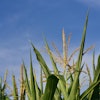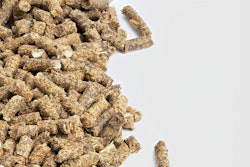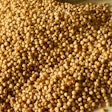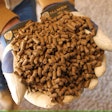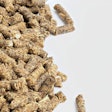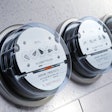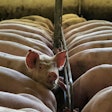
Contamination by mycotoxins, molds and other harmful compounds presents ongoing challenges for feed mills. Left unchecked, these contaminants can compromise animal health, reduce feed efficiency, and negatively affect productivity. Effective contamination management combines preventative practices, advanced testing and mitigation strategies to ensure safe, high-quality feed.
The risks and sources of contaminants in feed
Contaminants in animal feed arise from various sources, each requiring specific management techniques. Here are the most common.
- Mycotoxins: Produced by fungi such as Aspergillus, Fusarium and Penicillium, mycotoxins are toxic compounds that affect feed quality. Common mycotoxins include aflatoxins, deoxynivalenol (DON), fumonisins, zearalenone and ochratoxins, which can cause digestive issues, liver damage, reduced growth rates and immune suppression in animals.
- Heavy metals: Metals such as lead, arsenic, cadmium and mercury can accumulate in feed ingredients, especially grains and forages. Long-term exposure can harm animal health, lead to bioaccumulation, and potentially enter the food chain.
- Pathogenic bacteria: Salmonella and E. coli are examples of harmful bacteria that can contaminate feed and cause disease. These pathogens are of particular concern in facilities with poor sanitation or cross-contamination during handling.
- Pesticide residues: Some raw materials, such as grains, may carry pesticide residues that can be harmful if not properly managed.
Preventive practices for contaminant control
Effective contaminant management begins with prevention. Feed mills can adopt the following measures to minimize the risk of contamination:
- Ingredient sourcing and quality control: Work with suppliers who implement contaminant controls and provide quality certificates. Inspect each ingredient upon delivery, testing high-risk ingredients for mycotoxins and other contaminants.
- Proper storage conditions: Molds and mycotoxins thrive in warm, humid environments. By controlling moisture and temperature in storage areas, feed mills can limit fungal growth. Aeration, regular turnover and temperature monitoring keep conditions stable.
- Sanitation and hygiene protocols: Implement rigorous cleaning schedules for storage bins, equipment and transportation vehicles. Regularly disinfect surfaces, especially in areas handling raw grains, to minimize mold and bacterial buildup.
- Moisture control in production: Excess moisture in processing areas can foster mold growth. By drying grains to optimal moisture levels and maintaining controlled conditions during pelleting or extrusion, feed mills can reduce mold risk.
- Feed mill layout: A well-designed layout minimizes cross-contamination risks by separating clean and contaminated areas, streamlining flow and ensuring easy access for cleaning.
Latest testing and detection techniques
With contaminants like mycotoxins present in microscopic amounts, regular testing is crucial for detecting and addressing contamination early. Advances in testing technology provide feed mills with faster and more reliable options:
- Rapid strip testing: Simple, on-site strip tests can quickly detect major mycotoxins, including aflatoxins, DON and fumonisins. While not as precise as lab testing, they offer real-time screening to identify potential risks immediately.
- Enzyme-linked immunosorbent assay (ELISA): ELISA kits are widely used for mycotoxin detection, providing accurate results on-site within a short time. They’re useful for routine monitoring, offering quick turnaround on high-risk ingredients.
- Liquid chromatography-mass spectrometry (LC-MS): For precise and comprehensive testing, LC-MS remains the gold standard, capable of detecting a wide range of contaminants in very low concentrations. Though more costly, LC-MS is ideal for quality assurance programs that require detailed, lab-based analysis.
- Spectroscopy techniques: Near-infrared (NIR) and Fourier-transform infrared (FTIR) spectroscopy enable rapid, non-destructive testing for contaminants. These methods are increasingly popular for feed mills as they provide a quick assessment of feed without requiring intensive sample preparation.
- Predictive modeling and data analytics: Some feed mills employ predictive models using historical and environmental data (temperature, humidity, rainfall) to assess the likelihood of mycotoxin presence in grains. This proactive approach can prioritize testing efforts and mitigate contamination risks.
Mitigation strategies for contaminant reduction
Despite the best preventative efforts, contaminants can occasionally enter the feed supply. When this happens, feed mills have several options to mitigate their impact:
- Binders and adsorbents: Mycotoxin binders, such as clay-based (bentonite) and yeast cell wall products, can be added to feed to prevent mycotoxin absorption in animals. By binding to the mycotoxins in the digestive tract, these additives reduce toxicity and support animal health.
- Detoxification enzymes: Certain enzymes can break down mycotoxins into less harmful compounds, reducing their impact. These enzymes are often specific to certain mycotoxins, such as aflatoxins or fumonisins, and may be included in feed formulations.
- Thermal processing: Heat treatment methods like extrusion and pelleting can inactivate some bacteria and fungi. While not effective against mycotoxins, these processes reduce microbial contamination and support feed hygiene.
- Organic acid blends: Organic acids, such as propionic acid, can be used to inhibit mold growth in stored feed ingredients and finished feeds. Acidifiers create an inhospitable environment for fungi, extending shelf life and reducing contamination risk.
- Dilution: When contamination levels are manageable, dilution with clean ingredients can reduce contaminant concentration to safe levels. This approach, however, is not an advisable solution.
Benefits of a comprehensive contamination management program
Implementing a robust contamination management program provides several key advantages:
- Enhanced animal health and productivity: By minimizing contaminants, feed mills ensure animals receive safe, high-quality nutrition. Reduced toxin levels lead to healthier livestock, improved feed efficiency and higher productivity.
- Reduced liability: Regulatory bodies impose strict contaminant limits to protect animal welfare and human health. A strong contamination control program mitigates the risk of recalls, fines and legal liability.
- Operational efficiency: Preventative and mitigation measures minimize costly rework, storage losses and equipment wear from microbial contamination. Ultimately, these savings contribute to a more efficient, cost-effective feed production process.
- Improved brand reputation: Consumers increasingly demand safe food products. By prioritizing contamination management, feed mills can enhance their reputation for safety and reliability.
Contaminant control in feed milling demands an integrated approach, combining preventative practices, regular testing and effective mitigation strategies. By implementing a comprehensive contamination management program, feed mills safeguard the quality of their products and promote sustainable, safe and efficient production practices. As new testing and mitigation technologies emerge, feed mills have the opportunity to enhance feed safety, ensure animal welfare and protect the integrity of the feed supply chain.

